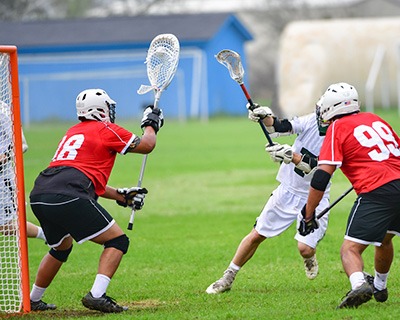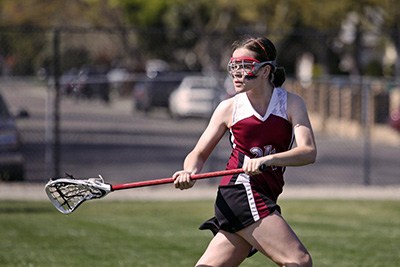If you're just getting started in lacrosse, it can be overwhelming learning to master the basics. But don't worry - there's a lot of great advice for you!
One of the most important skills for any beginning lacrosse player is passing accurately and efficiently. With the proper knowledge and practice, you can pass like a pro in no time!
In this blog post, we'll break down some tried-and-true lacrosse passing tips for beginners from professional coaches on how to become an expert passer as a beginner.
More...
Take Away Key Points:
Building Your Passing Skills: All You Need to Know
To become an advanced lacrosse player, you must master the passing tips for beginner lacrosse players. Our recommendations for lacrosse beginners will help you establish better ball control and sharpen your coordination with your receiving teammate.
So, find the best lacrosse passing drills below.
1. How to pass a lacrosse ball correctly?

You should perform the following steps to improve your game when passing a lacrosse ball. These include:
2. Best lacrosse passing drills
Here are some of the most popular lacrosse drills to improve your lacrosse pass, but also catching skills, cradling, dodging a defender's stick, etc.
Find the most suitable techniques to pass the ball in the right direction, and assist your teammate.
X passing lacrosse drills
The lacrosse pass requires the participation of all teammates. It also requires players to run at each other in north-south and east-west directions and form lines.
One player runs and exchanges a rhythm pass with an oncoming teammate. Then, he joins the end of the line and becomes the receiver.
With players coming together from four directions, the pass timing while avoiding other players is excellent practice for accuracy and coordination under pressure.
Two-line cross-lacrosse drills
These lacrosse drills are simplified versions of the X passing, but the players approach each other in the X formation.
First, they make two lines facing each other and complete the target passing as they cross. Then, they join back to the opposite line.
The hippo lacrosse passing
Players divide into two teams (ten players each) for practice. But, in the hippo drill, they must pass the ball within three to five minutes to the teammate, or the opposing team gets the possession.
The skills include faster decision-making and increased throwing abilities to improve their overall passing skills.

Straight wave drill
This is a more advanced lacrosse pall drill to practice passing while on the move. In groups of three, lacrosse players exchange passes. Simultaneously, they run behind and then ahead of each other in a weaving pattern.
The lacrosse passing drill is ideal for improving communication between players. In addition, they can practice catching and passing the lacrosse ball quickly in a coordinated pattern.
Four-on-four pressure drill
The lacrosse pass puts extra pressure on teaching players to break into transition. This is a straight lacrosse pass game of defense vs. offense. The offense must make a minimum of four passing actions before they are allowed to make a scoring action.
If the defense clears the lacrosse ball, they will become the offense to complete their four exchanges before an attack. Thus, attackers work on defense while practicing lightning-quick transitions.
Behind the back passing
The behind-the-back pass, also known as a lacrosse back pass, begins in reverse of a standard lacrosse throw. Players start with their lacrosse stick forward instead of over their shoulder. Next, they wrap the lacrosse stick around their side, releasing the lacrosse pass behind their back.
Very young players can use the tennis ball and practice passing and catching until they get enough power and strength to use real balls.
Flip passing
The flip pass is ideal for those who throw the lacrosse ball accurately to a nearby teammate. This is an excellent form for players who need to make a short pass.
The flip pass begins with the lacrosse stick in front of them, parallel to the ground. It ends with a quick flick of the front of the lacrosse stick, releasing the lacrosse throw over a short distance.
Bounce pass
A bounce pass is an excellent passing method if there's a defender between a player and his teammate and he is trying to get a lacrosse pass.
The lacrosse bounce pass offers the same method as a standard pass. However, the difference is that the lacrosse throw is released late to bounce the ball under the lacrosse stick of a defender.
Over the shoulder pass
The over-the-shoulder pass is another convenient method used when a lacrosse player moves the ball up the field. Another situation is when he clears out of the defending zone.
The thrower of the over-the-shoulder lacrosse pass releases the ball early. Then, he performs the pass higher, allowing the receiver to catch the lacrosse ball over their shoulder in stride. Thus, they will keep forward momentum.
Sidearm pass
The sidearm pass is an excellent method when you must find a new angle to make a lacrosse pass with a defender close in front of you.
If you're wondering how to protect your team and successfully throw a lacrosse ball around another lacrosse player, this is a crucial lacrosse drill.
The sidearm pass is a specific lacrosse throw involving a lacrosse throw parallel to the ground on the player's side instead of overhead. Meanwhile, he slides his top hand down towards the butt end of the stick.
Underhand pass
The underhand pass is ideal for throwing a lacrosse ball around a close defender when players make contact. This lacrosse throw might be slower than other lacrosse passes. However, this drill is sometimes the best way to throw under a defender's arm during a check.
Overhand pass
The overhand pass is an excellent practice to improve the accuracy of your passes. These drills require players to take a correct stance and position their feet. They must use proper footwork, keeping their hips tucked when throwing, and keep the stick cocked upwards with the head pointed down.
The players performing these drills should focus on tossing the ball with a reasonable force to reach its intended target without bouncing off it.
As they get better at the drills, they can increase the distance between themselves and their partner while maintaining accuracy and consistency. In addition, these challenging but rewarding drills can improve players' precision in passing.
Frequently Asked Questions
When passing a lacrosse ball?
When passing a lacrosse ball, you must take an athletic stance and position your hands away from your body. While making the pass, push with your top hand & snap your wrists while pulling the stick with your bottom hand. Your front foot must also step toward your direction for advanced accuracy.
How do I get better at passing in lacrosse?
To get better at passing, especially for beginners, you must have proper mechanics and follow through. You can combine the drills with regular repetition of throwing the ball. You can also add ground balls, catch-the-ball practice, and similar practice drills to help you take your game to the next level.
How do you throw a long pass in lacrosse?

You must take a larger step into the pass and release the ball slightly earlier than a regular pass. A strong step and throw, in combination with an early release, result in the distance further than the pass.
How can I make my pass stronger?
To make your passes stronger, you must repeat the passing drills and practice as much as possible. Combining multiple drills to form sufficient power in your passing game would be best.
What is the 3-second rule in lacrosse?
The three-second rule explains the situation in which you catch the ball and have three seconds to either pass it or change its cradle. If you cannot perform so, the possession is given to the opposing team.
Conclusion
Passing and catching are cornerstones for a successful lacrosse player. With careful practice, you can master lacrosse passing tips for beginners and elevate your game.
Developing an understanding of strategies and fundamentals will also increase your ability to have control in a game situation. As a result, you become more than just another player.
Instead, you can truly become a dominant force on the field.
